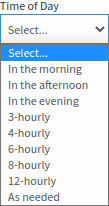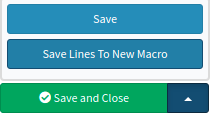Workflow Event: Dispense
A Dispense Form is a form that a Practitioner will use to dispense medication to a patient and allows the Pharmacist or responsible person to dispense the items to the Patient from within the Practice instead of issuing a prescription that the Patient will have filled at an external Pharmacy.
When a practice is registered as a dispensing practice with a dispensing license as obtained by and accredited with the South African Pharmacy Council, the practitioner is able to supply medication to a patient directly from the practice.
- The contents of this User Manual will consist of the following information:
- Dispensing Info
- Dispensed Items
- Log in to the GoodX Web App with your GoodX username and password.
- The main Diary screen will open.

- Click on the desired booking to access the Diary sidebar.

- Click on the Clinical button to access the Clinical Case screen.

- The Clinical Case screen will open.

- Click on the Forms Library drop-down menu on the sidebar.

- Select the form named Dispense.

- The Dispense form will be added to the sidebar under the Active Forms section.

- The Dispense form will open automatically when the form is added to the Active Forms.

Dispensing Info
All information on when the medication will be dispensed to the patient, as well as the practitioner and practice that will be dispensing the medication.
- An explanation will be given for each field in the Dispensing Info section:
![]()
- Dispense Date: The date when the medication will be dispensed to the patient. The system will automatically give the current date.
- Click on the Dispense Date field to open the Calendar to select the date when the medication was or will be dispensed to the patient.

- Click on a date to make a selection.
![]()
- Dispensing Practice: The name of the practice that will be dispensing the medication to the patient. The practice will need to be registered as a dispensing practice with a dispensing licence in order to dispense medication to patients.
- Click on the Dispensing Practice field and type the name of the practice. The Dispensing Practice field is a free text field.
or
- Click on the Right up arrow button to search for and insert a practice from the Medibase List Search screen.
![]()
- The Medibase List Search screen will open.

- For more information on how the Medibase List Search screen works please refer to the user manual: Medibase List Search.
![]()
- Prescribing Doctor: The name of the practitioner who has prescribed the medication to the patient.
- Click on the Prescribing Doctor field and type the name of the practice. The Prescribing Doctor field is a free text field.
- Click on the Right up arrow button to search for and insert a doctor/practice's information from the Medibase Search List screen.
![]()
- The Medibase List Screen will open.

- For more information on how the Medibase List Search screen works please refer to the user manual: Medibase List Search.
Dispensed Items
A list of the items that have or will be dispensed to the patient.
- Click on the Clear button to empty the entire Dispensed Items section, if the practitioner would like to remove all the items that have been added to the list.
![]()
- Tick/Untick the Minimal/Expanded check box to expand or collapse the available options on the Dispensed item lines.
![]()
Please Note: The Dispensed Items lines will be Expanded by default and the dosage field will only be available in the Expanded view.
- The following fields will be available on each item that will be dispensed:

- Code (Nappi): The National Pharmaceutical Product/Pricing Index code of the product as supplied by Medikredit for the selected product. The Code (Nappi) field will populate automatically from the Medicine item that is selected.

- Medicine: The item that will be prescribed by typing the name or code of the medication in the Medication field to add it to the line.
- Click on the Medicine field to enter the name or code of the desired medication that the practitioner would like to have dispensed.
- A list will appear from which the practitioner is able to select the desired medicine item, the list will shorten as the practitioner types. Only 1 character is needed for the list to appear.

- Click on the desired item to make a selection.
- Once a selection has been made the Active Ingredients and Code (Nappi) will automatically be filled in.
Please Note: The list will disappear if the practitioner takes too long to select the desired item.

- Dosage: How many items should be taken each time the medication is administered. The Dosage field will by default be set to 1.
- Click on the Dosage field to type the desired amount or Click on the up and down selectors to select the desired amount.

- Route: How the medication should be administered.
- Click on the Route drop-down menu to select a relevant option:

- An explanation will be given for the Route options of how the medication needs to be taken or administered:
- Oral: Swallowing the medication.
- Rectal: Placing the medication into the rectum.
- Inhaled: Breathed in through the mouth, for example, through an inhaler or mask.
- Nasal: Taken up through the nose.
- Topical: Applying the medication to the skin.
- Infusion: Administered through a needle or catheter. The procedure will be performed by a practitioner or nurse.
- Intramuscular: Injecting the medication deep into the muscle tissue. The procedure will be performed by a practitioner or nurse.
- Intravenous: Administered via a drip where the needle is placed into the vein. The procedure will be performed by a practitioner or nurse.
- Enteric: Crushed before being taken orally.
- Otic: Will need to be administered into the ear canals.
- Ophthalmic: Applying the medication into the bottom or top lids of the eyes.
- Sublingual: Dissolved under the tongue.
- Buccal: Applied between the gums and the inner lining of the cheek.
- Transdermal: Administered through a transdermal patch that is placed on the skin.
- Subcutaneous: Administered using a short needle and injecting the medication between the skin and muscle. The procedure will be performed by a practitioner or nurse.
- Vaginal: Administered or placed into or through the vaginal canal.
- As prescribed: The practitioner will advise the patient on the best possible option on how to take the medication.

- Frequency: How many times a day the medication should be taken. The Frequency field will by default be set to 1.
- Click on the Frequency field to type the desired amount or Click on the up and down selectors to select the desired amount.

- Days Supplied: The number of days that the medication that will be dispensed will be provided.
- Click on the Days Supplied field to type the desired amount or click on the up and down selectors to select the desired amount.

- Total Quantity: The total number of the specific items that will be given to the patient.
- Click on the Total Quantity field to type the desired amount or click on the up and down selectors to select the desired amount.

- Time of Day: Gives the patient an indication of a time frame when the practitioner suggests that the medication need to be taken.
- Click on the Time of Day drop-down menu to select a relevant option:

- An explanation of the Time of Day that the prescribed medication needs to be taken will be explained:
- In the morning: To be taken as early as possible after sunrise, between 6 am and 9 am.
- In the afternoon: To be taken after 12 pm before 6 pm.
- In the evening: To be taken after 6 pm before 9 pm.
- 3 hourly: To be taken every 3 hours.
- 4 hourly: To be taken every 4 hours.
- 6 hourly: To be taken every 6 hours.
- 8 hourly: To be taken every 8 hours.
- 12 hourly: To be taken every 12 hours.
- As needed: To be taken when the patient feels that they need to take the medication.

- Meal Relationship: To indicate if the medication should be taken before, after or with meals.
- Click on the Meal Relationship drop-down menu to select a relevant option:

- An explanation of the Meal Relationship options will be given:
- With meals: The prescribed medication needs to be taken during mealtime.
- Before meals: The prescribed medication needs to be taken, for example, at least 30 min to 1 hour before mealtime.
- After meals: The prescribed medication needs to be taken, for example, at least 30 min to 1 hour after mealtime.

- Directions: How and when the prescribed item is to be used in the Directions field and can also be used as a free text field. The Directions field will be filled in by default when the screen is opened and will update as the practitioner makes their desired selections.
- It is possible to use Prescription Codes that have been set up in the GoodX Desktop.
- Type the shortcode of the Signata that would like to be added to the item in the Directions field.
- Click on the exclamation mark (!) button next to the Directions field to calculate the directions from the entered values, which will also calculate the number of items that need to be dispensed.
- The Directions field will update.

- Click on the X button to revert the changes that have been made.
![]()
- The changes will be removed.

- Active Ingredients: A list of active ingredients that are in the medication that will be dispensed. The Active Ingredients field will automatically populate when a medication is selected.
- Click on the + button to add another line to the dispense list.

- Click on the - button to delete the line from the dispense list.

- Click on the Add Script Item button to add another line to the dispense list.

- Click on the + button in the Dispenser Signature section to add the signature of the person who will be dispensing the medication to the patient.

- The Signature Capture screen will open.

- For an extensive explanation on how to add a signature to a clinical form please refer to the user manual: How to add a Doctors Signature.
- Click on the Complete button to finalise the form when satisfied with the content.

- The Complete button will change to a completed status.

- Click on Close to return to the main Diary screen without saving.

- Click on the Save and Close drop-up menu for more saving options.

- Save: The user is able to save the changes that have been made to the form without closing the form.
- Save Lines To New Macro: Allows the user to create a new macro.
- For an extensive explanation of the feature please refer to the user manual: Macros (Billing Combinations)
- Click on Save and Close to save the Clinical form and close to return to the main Diary screen.

Last modified: Friday, 22 April 2022, 7:20 AM
